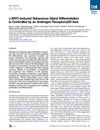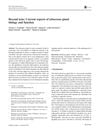TLDR Without keratin 10, there's more growth and development of oil-producing skin cells.
The study provided strong evidence that the targeted deletion of keratin 10 (K10) in mice led to increased proliferation and differentiation of sebocytes, the cells in sebaceous glands. This change was not associated with the induction of proliferation-associated keratins K6, K16, and K17. K10−/− mice exhibited accelerated sebaceous gland cell turnover and increased secretion of sebum, including wax esters, triglycerides, and cholesterol esters. Additionally, levels of major epidermal lipids such as ceramides and cholesterol were elevated, while glycosylceramides and sphingomyelin were reduced, without changes in sphingolipid biosynthesis. The amount of Cer(OS) bound to the cornified envelope, as well as loricrin and involucrin levels, remained unchanged. The study concluded that the altered composition of the suprabasal intermediate filament cytoskeleton in K10−/− mice promoted the differentiation of epidermal stem cells towards the sebocyte lineage.
421 citations
,
September 2003 in “Development” Stem cell behavior varies with stimuli, and lineage changes can happen without affecting stem cell division.
 122 citations
,
June 2002 in “Genes & Development”
122 citations
,
June 2002 in “Genes & Development” Keratin 17 is crucial for early hair strength and cell survival.
686 citations
,
February 2002 in “Current Opinion in Cell Biology” Keratin filaments are crucial for cell structure and protection, with ongoing discoveries about their genes and functions.
297 citations
,
January 2002 in “Development” Overexpression of ΔNLef1 in mouse skin leads to hair loss, cysts, and skin tumors.
555 citations
,
July 2001 in “Genes & Development” Tcf3 and Lef1 are key in deciding skin stem cell roles.
315 citations
,
June 2001 in “Nature Genetics” 201 citations
,
May 2001 in “Proceedings of the National Academy of Sciences” Overexpression of COX-2 in mice skin causes abnormal skin and hair development.
338 citations
,
April 2001 in “Current Biology” c-Myc activation in mouse skin increases sebaceous gland growth and affects hair follicle development.
130 citations
,
April 2001 in “Journal of Investigative Dermatology” The keratin tail is crucial for skin structure and function.
46 citations
,
November 1998 in “Experimental Cell Research” K15 gene is mainly active in the basal layers of hair follicles and epithelia, aiding early skin cell development.
318 citations
,
October 1998 in “The Journal of Cell Biology” Keratin 17 is important for skin development and may help define skin cell types.
 107 citations
,
August 2012 in “Seminars in Cell & Developmental Biology”
107 citations
,
August 2012 in “Seminars in Cell & Developmental Biology” The document concludes that understanding the sebaceous gland's development and function is key to addressing related skin diseases and aging effects.
 60 citations
,
February 2013 in “Cell reports”
60 citations
,
February 2013 in “Cell reports” The balance between androgen receptor and p53 is crucial for sebaceous gland differentiation.
22 citations
,
July 2016 in “Cellular and Molecular Life Sciences” Genetic changes in mice help understand skin and hair disorders, aiding treatment development for acne and hair loss.
 97 citations
,
September 2016 in “Reviews in Endocrine and Metabolic Disorders”
97 citations
,
September 2016 in “Reviews in Endocrine and Metabolic Disorders” The sebaceous gland has more roles than just producing sebum and contributing to acne, and new research could lead to better skin disease treatments.
466 citations
,
June 2009 in “Experimental dermatology” We now understand more about what causes acne and this could lead to better, more personalized treatments.



